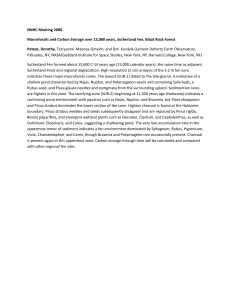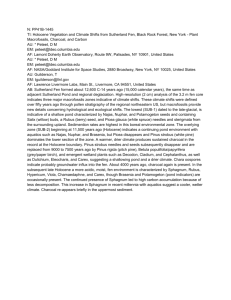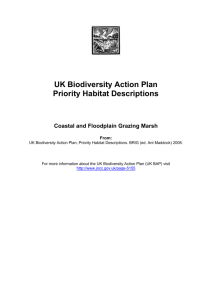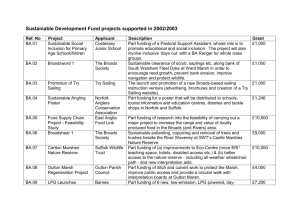Large Copper Action Plan
advertisement
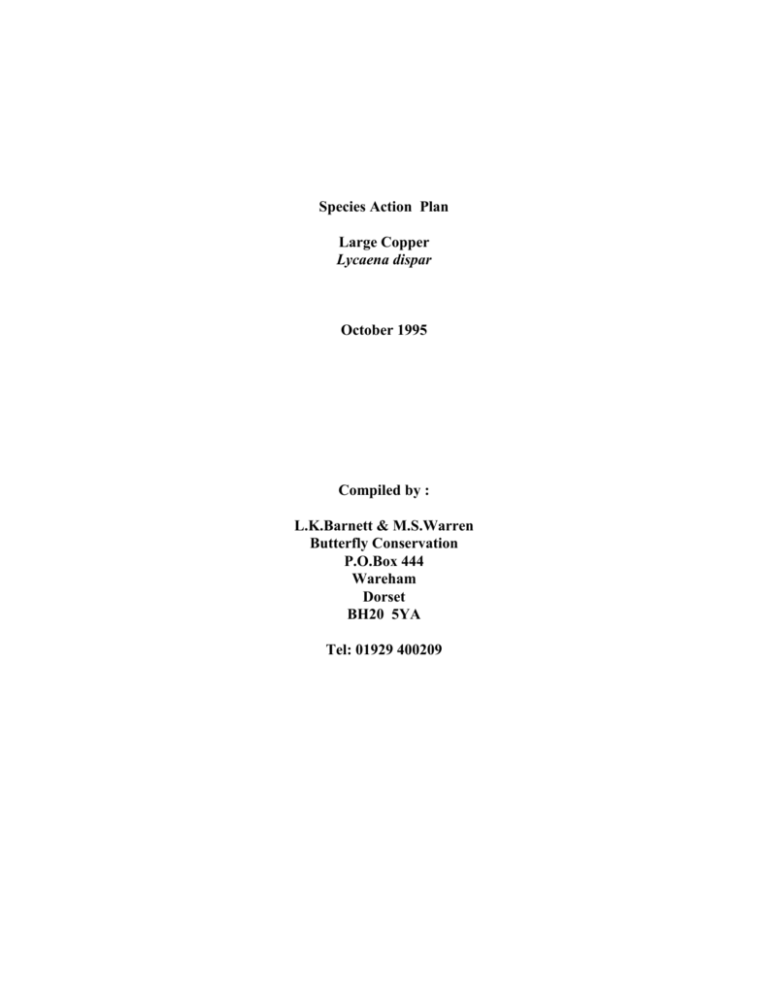
Species Action Plan Large Copper Lycaena dispar October 1995 Compiled by : L.K.Barnett & M.S.Warren Butterfly Conservation P.O.Box 444 Wareham Dorset BH20 5YA Tel: 01929 400209 This species action plan is an unpublished working document produced to focus and coordinate the conservation of the Large Copper butterfly in the UK over the next five to ten years. It has been prepared under the Action for Butterflies project which is funded by WWF-UK, English Nature, the Countryside Council for Wales and Scottish Natural Heritage. The Action Plan was prepared in consultation with the following organisations in the hope that they will participate in the actions outlined: Broads Authority, RSPB (Norfolk), Norfolk Wildlife Trust, Cambs Beds & Hunts Wildlife Trust, Keele University, NRA, MAFF and English Nature. Outline Paper / First draft Pathfinder Meeting Second Draft Final Draft Approved by Steering Group :April 1995 : May 1995 : June 1995 : August 1995 : October 1995 Acknowledgements We are grateful to the following for their comments at the Pathfinder meeting and/or on subsequent drafts; Jane Madgewick, Clive Doarks, Gary Kennison, Jo Parmenter (all Broads Authority); Andrew Pullin (Keele University), Eric Duffey (Woodwalton Fen Committee), Matthew Shardlow (RSPB Norfolk), George Taylor (Norfolk Wildlife Trust), Alison Craig (Cambridge, Beds And Northants Wildlife Trust), Ian McLean, Dave Sheppard, Alan Bowley (English Nature), Adrian Fowles (Countryside Council for Wales), Dave Phillips (Scottish Natural Heritage) & Michael Chinery. Butterfly Conservation (the British Butterfly Conservation Society) has an overriding objective to ensure a future for butterflies, moths and their habitats. In order to achieve this objective its aims are to raise public awareness of the plight of our butterflies and moths. to reduce the decline of commoner species and to increase the numbers of rarer species. to work with and advise other conservation groups, local bodies and agencies on techniques of land management which favour butterflies and moths and related wildlife. to acquire and manage habitats for butterflies and moths. to encourage the research (both at amateur and professional levels) on butterflies and moths. support and encourage butterfly and moth conservation world-wide. Registered Office of Butterfly Conservation: Shakespeare House, High Street, Dedham, Colchester, Essex, CO7 6DE. Registered in England No. 2206468 Registered Charity No. 254937. 2 CONTENTS Page Summary 4 Part 1 Overview 1.1 1.2 1.3 1.4 Priority Statement Broad Objectives Legal Status Status and level of biological knowledge 5 5 5 6 Part 2 Biological Assessment 2.1 2.2 2.3 2.4 2.5 Introduction Ecology Distribution and Population Limiting Factors Resume of Conservation to Date 7 7 8 9 10 Part 3 Actions and Work Programme 3.1 3.2 3.3 3.4 3.5 3.6 3.7 3.8 3.9 Policy and Legislative Site Safeguard And Acquisition Land Management Species Management and Protection Advisory International Future Research, Survey and Monitoring Communications and Publicity Review Abbreviations References Appendix 1 Appendix 2 13 13 13 14 14 15 15 16 16 16 17 Current Distribution of the Large Copper in The UK. A. Factors Affecting Large Copper Larvae Mortality. B. Conditions That Management For The Large Copper Should Aim For . 3 19 20 Summary The Large Copper, Lycaena dispar is listed in the UK Red Data Book as an extinct species. It is endangered in Europe, and protected under the Bern Convention and Habitats Directive. Its world status is endangered. The Dutch univoltine populations which have great similarities to extinct British ones, are particularly at risk as they are probably restricted to one locality in the Netherlands. It is protected in the UK for sale only. In north-west Europe L. dispar breeds in open fenland habitat where its larvae feed exclusively on Great Water Dock, Rumex hydrolapathum. The major threat to the butterfly in the UK is the invasion by woody plants reducing the areas of open fen vegetation. This may happen due to lack of management, or to the fen habitat drying out due to human activities (e.g. water abstraction) or in the longer term by natural processes, such as peat formation. Other threats include high water tables in fenland habitat during autumn/winter for prolonged periods (due to the rise in sea level and lack of flood control) and in the longer term the very limited appropriate donor populations in Europe (i.e. just one reserve in the Netherlands). The major objectives of this Action Plan are divided into two levels. The immediate objective is to determine the feasibility of a Large Copper re-establishment programme in the UK. If this proves to be possible, the longer term objective of the Plan is to restore a viable network of interconnected populations of the univoltine race in the UK. The immediate objectives of this plan will be achieved by research aimed at improving our knowledge of the ecology and habitat requirements of the univoltine race of the Large Copper, and the management techniques required to create appropriate conditions for the Water Dock (especially in the Broads); and by assessing the suitability of present fen habitat for the butterfly and the potential for restoring suitable habitat. The longer term objective will be achieved through strategic introductions into suitable habitats. The Action Plan embodies the idea that all actions within it should be compatible with management of fen habitat as a whole, supporting such documents as the Broads Plan and Fen Management Strategy. The Action Plan covers the next ten years, will be monitored annually and reviewed in the year 2000 or earlier time if the situation demands. 4 Part 1 Overview 1.1 PRIORITY STATEMENT The Large Copper, Lycaena dispar is included in the British Red Data Book of Insects as an extinct species (Shirt, 1987), and the extent of its decline in Europe has merited its inclusion on the Bern Convention. It is also currently listed as endangered in the IUCN (World) Red Data Book (IUCN 1990), and as an endangered species in Europe (Heath 1981). High priority should therefore be afforded to both assessing the suitability of existing fen habitat and the potential for restoring suitable habitat for the Large Copper, with the long term aim of re-establishing viable populations in the UK. Such a programme has a clear link with conservation of the species in The Netherlands as it has the potential to provide an important reserve population for the highly endangered univoltine subspecies. 1.2 BROAD OBJECTIVES 1) Conduct research on the suitability of remaining fen habitat for the univoltine race of the Large Copper, and the viability of a re-establishment programme. 2) Encourage the maintenance and restoration of potential habitats. 3) Long term objective to restore a viable network of interconnected populations of the univoltine race. 4) Incorporate the actions within this plan with fen habitat as a whole. 1.3 LEGAL STATUS The Large Copper is listed on Schedule 5 (for sale only) of the Wildlife and Countryside Act 1981. It is also listed under Annexes II and IV of the EC Habitats Directive (1992) as a species requiring strict protection in its own right (IV) and designation of Special Areas of Conservation (II). It is protected under the Convention on the Conservation of European Wildlife and Natural Habitats (Bern Convention). The Large Copper has been proposed for full protection under Schedule 5 of the Wildlife and Countryside Act. 5 Table 1 The Status and Level of Biological Knowledge Population Knowledge of -size Represented in Britain during 1980s at one site, Woodwalton Fen in Cambridgeshire, though this population is now believed to be extinct -trend, numbers Probably extinct -trend, range Probably extinct -status Good -trends Good -conservation requirements Moderate 6 Part 2 Biological Assessment 2.1 INTRODUCTION The British univoltine populations of the L. dispar became extinct in the mid 19th century, having been found mainly in the East Anglian fens. Several attempts have been made to re-establish the species to Britain, most recently at Woodwalton Fen in Cambridgeshire using the closely related Dutch univoltine populations. The reintroduced colony is believed to be too small now to survive in the wild without protection and this plan focuses on investigating alternative sites where it might be possible to re-establish free-living univoltine populations once more in Britain. 2.2 ECOLOGY There is virtually nothing known about the life history of the extinct British populations except that which is inferred from the Dutch populations. The two are similar in that they both have only one generation per year (univoltine) and feed solely on one food plant, the Great Water Dock, Rumex hydrolapathum. This is in contrast to populations elsewhere in Europe which have a bivoltine life cycle and feed on a number of species in the genus Rumex. The Dutch populations of L. dispar lay eggs during July and August on the leaves of the Great Water Dock in open fenland areas where the food plant occurs at a high density in relatively open, sunny positions (Duffey 1968, Bink, 1972). The plants used are rarely in low-lying positions as eggs laid in such conditions experience high mortality if flooded for lengthy periods. Newly hatched larvae are yellow with long hair, but they quickly turn green. On hatching the larvae begin feeding on the underside of the leaves, creating a characteristic “window” since the upper epidermis is not eaten. This is easily seen by the experienced observer, making detection and counting of larvae relatively easy. Larvae reach the second instar and begin diapause (hibernation) in mid-September, characterised by cessation of feeding and migration down the plant and on to the ageing leaves around the base. They do not appear to move on to surrounding vegetation. The diapause state is not obligatory as it can be averted by exposing the first two larval instars to long photoperiods and high temperatures (Pullin et al., 1995), but under normal conditions the shortening photoperiods of early September induce diapause. The hibernating larvae acquire a reddish tinge and stay in their overwintering site until warm spring weather (around April) encourages them to crawl back up the plant on to young growing shoots. They then continue feeding until pupation in June, which takes place either on the plant or on nearby vegetation. The adults are on the wing in July and August. Little is known about adult behaviour and particularly dispersal, partly due to the difficulty of following the butterfly in fen habitats and the low density at which populations seem to exist. Some evidence from population monitoring in The 7 Netherlands suggests that the adults may be able to colonise habitats as far as 20 km away from existing populations, presumable by flying along water courses (Pullin et al., 1995). 2.3 DISTRIBUTION AND POPULATION L. dispar is distributed over a large area of Europe and into Asia. It is commonly divided into three main subspecies (e.g. Higgins and Hargreaves, 1983): L. dispar dispar Haworth, confined to England; L. d. batavus Oberthur confined to The Netherlands and the more distinct L. d. rutilus Werneburg., which is double brooded and widespread, though declining in Europe. L. d. dispar and L. d. batavus are regarded as being very similar; both in their physical appearance and univoltine physiology. More detailed treatments describe other European subspecies (Bretherton 1966). There is very little information on the species taxonomy and distribution in eastern Europe and Asia. British Populations L. d. dispar was never common in England and was first recorded in 1749 from Dozen’s Bank near Spalding, Lincolnshire (Heath, 1983). There is good evidence that its range in the early nineteenth century included Lincolnshire, Huntingdonshire and Cambridgeshire across to the Norfolk Broads. Less reliable information suggests that there were also more westerly populations on the Somerset levels and the Wye marshes in Monmouthshire (Pullin et al 1995). The species was probably already in decline when it was first recorded, as it seems to have disappeared rapidly from Lincolnshire and was last recorded in Huntingdon at Holme Fen around 1847 or 1848 and in Cambridgeshire at Bottisham Fen in 1851. The last British record may well be from the Norfolk Broads where specimens were taken at Ranworth in 1860 and Woodbastwick in 1864 (Irwin 1984). The univoltine sub species is now represented in the UK at only one site, Woodwalton Fen, Cambridgeshire, where the closely related Dutch Large Copper was introduced in 1927. However this population is now believed to be extinct. Dutch Populations L . d. batavus was not discovered until 1915 at Nyetrine near Wolvegain Friesland, and was probably already declining at this time. It has since been recorded at just 13 sites (excluding introductions) and by 1970 was reduced to small populations within a marshland area in north-west Overijsel and south-east Friesland (Bink, 1970). In 1992 only four populations were known to exist, and only one of these was substantial and within an extensive wetland area. In 1993, it was only recorded in the Weerribben 8 National Park and the univoltine sub species is now considered highly endangered in a world context (Wynhoff & van Swaay, 1995). 2.4 LIMITING FACTORS Historical There is a consensus of opinion that the decline of the Large Copper was an inevitable consequence of habitat loss due to widespread drainage together with general intensification of agriculture. In some areas (e.g. the Broads) changes in habitat management may also have played a role in its decline. Once confined to small, isolated populations, its extinction may have been accelerated due to overcollection and /or random fluctuation of small populations, but these can only be seen as secondary causes. Possible Current and Future Limiting Factors Reduction in the area of open fen vegetation due to invasion by woody plants, from lack of management, or drying out of fens by natural processes, such as peat formation in the long term, or possibly as a result of human activities (e.g. water abstraction). High water tables in fen habitat during autumn/winter for prolonged periods (due to the lack of flood control and rise in sea level). Difficulties of implementing practical management regimes that maintain an open vegetation structure. Excess nitrates and phosphates in ground and surface water may cause deterioration of vegetation. Inability to keep a self-sustaining population at Woodwalton Fen, indicating that the habitat is either too small, or not managed ideally for the species, or that we have an incomplete understanding of the requirements of the species, or that the genetic diversity of the greenhouse colony is too low to allow it to be viable in the wild, or a combination of all four factors. Potential appropriate donor populations in Europe are now very limited (i.e. just one reserve in the Netherlands). 9 2.5 RESUME OF CONSERVATION TO DATE The Large Copper is famous among British Lepidopterists as one of the earliest recorded butterfly extinctions and for the early attempts at re-establishment. Since the extinction of the British populations of the Large Copper, a number of attempts have been made to re-establish populations in by introducing one of the European subspecies. The bivoltine sub species L. d. rutilus was introduced to Wicken Fen, Cambridgeshire, in 1909 (Verrall, 1909) and following years with little success; to Greenfields, Co. Tipperary in 1913 and 1914 by E.B. Purefoy, where the colony survived until 1928; and to the Norfolk Broads in 1926 at Woodbastwick, where it survived until 1936 (Duffey, 1968). The univoltine subspecies L. d. batavus was introduced to Woodwalton Fen, Huntingdonshire in 1927. This colony has been maintained to the early 1990s, through a policy of protecting larvae and by supplementing the population by further adult releases from cage-raised stock. It was also introduced to Wicken Fen, Cambridgeshire, in 1930 where it survived until 1942; to the Norfolk Broads, near Surlingham, in 1949 where it survived for only one year; and to Greenfields, Co. Tipperary, in 1926 where it survived until 1938, and again in 1943 with survival until 1953 or 1954 (Oates and Warren, 1990). Although many attempts at re-establishment of the Large Copper have been made little information has been gained on why the introductions failed. The mistake made in the past was that many of the such attempts were carried out with little knowledge of the butterfly’s precise ecological requirements, and with little or no detailed monitoring. The notable exception to this is the work of Eric Duffey at Woodwalton Fen which is described below. The Woodwalton Population In the period between the initial introduction to Woodwalton in 1927 and 1955 there is no evidence that the reintroduced populations of L. d. rutilius and later of batavus survived for any length of time without protection from predators and parasitoids by caging larvae in the spring. However , no extensive records were kept and no scientific assessment can be made. From 1955 the warden kept records of the numbers of larvae and pupae and timing of the life cycle, and in 1960 an experiment was set up to compare the survival of a wild and a caged colony (Duffey 1968). The wild population never reached high numbers from the 24 larvae introduced, and the population went extinct in 1966 and may have done so sooner if some immigration of individuals from the caged population had not occurred. An abnormal flood in July of 1968 caused a dramatic decline in the number of eggs in the remaining population. By 1969 only five adults remained and these failed to reproduce leading to extinction of the Woodwalton colony (Duffey and Mason, 1970). However, several captive populations of the Woodwalton stock remained, and over 1000 adults 10 were used to re-establish the colony in 1970 (Duffey, 1977). These were added to, from the same sources, from 1971 to 1973. Subsequently, large annual reductions in size of the population made it necessary to constantly replenish the wild stock with individuals reared under greenhouse conditions. In 1987 a joint Butterfly Conservation (BC) and English Nature (EN) project started recording changes in the wild population at Woodwalton Fen. Michael Chinery (BC) and Ian McLean (EN) co-ordinated annual counts carried out by volunteers from the Cambridgeshire and Essex Branch of BC. A large release of adults was made from greenhouse stock and was followed by annual counts of adults, eggs and larvae on the fen. Even with the large numbers of adults present that year and the fine weather during the flight period, transect counts along pathways around the principal breeding areas where the butterfly was known to breed resulted in only a few sightings. Subsequently counts were confined to eggs and larvae. A rapid decline was recorded from 1987 to 1989 for both eggs and larvae. From 1989 onwards numbers were more stable at a low level, but by the summer of 1994 after extensive flooding the previous winter there was no evidence that the Large Copper existed on the fen from the re-establishment (Ian McLean pers. comm). Current Studies A further project was started by Ian McLean and Andrew Pullin in 1989, with the aim of studying the ecology of the Woodwalton population, leading to management proposals that would allow a self-sustaining population on the fen (Pullin et al., 1995). The work concentrated on larval mortality, and the effect of management on the population. In addition, the project aims to identify sites in eastern England (within the species former range) that are suitable for trial re-establishments. Recently, these studies have concentrated on the Norfolk Broads. This is the only extensive area of fen habitat that remains in the UK and is thus one of the few areas that might eventually support a selfsustaining colony of the Large Copper. Results from this project and studies on the Dutch populations have indicated factors that appear to be important regarding larval mortality, and the type of conditions that management should be aiming at to maintain a self-sustaining population on receptor sites. These are detailed in Table 1 (sections A and B). Nature Conservation in the Broads The Broads Authority produced a Draft Broads Plan in 1993 which attempts to address the differing demands on the Broads. It was produced as the result of many hours of discussion by people with specialist knowledge and specialist interest in the Broads. The Plan is not only concerned with conserving and enhancing the natural beauty of the Broads but also controlling its development so that patterns of commercial use do not diminish its quality. 11 The Broads Authority, working in partnership with English Nature, is committed not only to halting the decline of the fens but to restoring all the fen which has been recently lost to scrub. As well as considerable resources being channelled into fenland management, the Broads Authority and English Nature has embarked on the preparation of a fen management strategy. This is a co-ordinated approach involving land owners and managers to put into practice a long-term management plan for the whole of the fens. The first stage was to set up a three-year botanical survey to analyse and map the fen resource, and to collate historical records and management. This information together with results from management trials and information on the distribution of birds, invertebrates and mammals is intended to provide a database to help define distribution priorities. Of the areas that are likely to be suitable for the Large Copper in the Broads (i.e. with Water Dock) over 90% are already SSSIs and many are covered by management agreements (with EN or the Broads Authority). In addition an Environmentally Sensitive Area has become successfully established in the Broads, which is a cornerstone in maintaining and enhancing the distinctive Broads grazing marsh landscapes. Other Current Studies Comparative studies of habitat are now underway in the Weeribben and the Broads to assess the suitability of re-introduction sites in the latter (Pullin & Webb, in press). Additionally autoecological research is focusing on male territorial requirements, larval overwintering survival and genetic diversity. 12 Part 3 Actions and Work Programme Organisation(s) primarily responsible This section has been divided into the standard headings Policy and Legislative; Site Safeguard and Acquisition; Land Management; Species Protection and Licensing; Advisory; International; Future Research and Monitoring; Communications and Publicity; Review. Actions are given a low, medium or high priority. The lead organisation(s) concerned for each action is/are named. 3.1 POLICY AND LEGISLATIVE Action 1 PRIORITY: HIGH ESSENTIAL Promote beneficial land management on existing fen habitats and potential habitats to produce open fen habitat. 3.2 SITE SAFEGUARD AND ACQUISITION Action 2 PRIORITY: LOW Continue to safeguard all potential introduction sites once these are identified (see also action in future research and monitoring) by acquisition as nature reserves and designation as SSSIs. Action 3 EN, BA PRIORITY: LOW Continue to enforce the Broads Plan. 3.3 EN, BA, NRA All LAND MANAGEMENT Action 4 PRIORITY: HIGH Continue appropriate management of existing open fen and extend this habitat by clearance of willow scrub, maintaining high water tables and reducing fluctuation in water levels (where possible) under the control of land managers etc. 13 All Action 5 PRIORITY: HIGH Integrate management for the Large Copper with that for fen habitat as a whole. Action 6 BA, EN PRIORITY: MEDIUM (LONG TERM) Encourage the restoration of suitable breeding habitats in potential establishment areas. KU, BC, EN 3.4 SPECIES MANAGEMENT AND PROTECTION Action 7 PRIORITY: HIGH (LONG TERM) Conduct strategic reintroductions into suitable habitats, using genetically diverse stock obtained from wild populations in the Netherlands. Action 8 KU, BC, EN PRIORITY: LOW Encourage and enforce legislation to prevent collection of the Large Copper following reintroduction. EN Action 9 PRIORITY: LOW Arrange appropriate wardening at all existing and future re-establishment sites to prevent illegal collecting or accidental disturbance and to help with monitoring. EN, BC 3.5 ADVISORY Action 10 PRIORITY: MEDIUM Advise site owners/managers on practical habitat management for the Large Copper . 14 EN, BC 3.6 INTERNATIONAL Action 11 PRIORITY: HIGH Encourage governments and conservation agencies to cooperate with the conservation of L. dispar butterflies throughout their range, especially the univoltine race in the Netherlands. 3.7 JNCC, KU, BC, DA(N) FUTURE RESEARCH, SURVEY AND MONITORING Action 12 PRIORITY: HIGH (URGENT) Identify the ecology and habitat requirements of the univoltine race of the Large Copper; appropriate habitat management techniques, and environmental conditions in potential re-establishment sites. Action 13 KU, BC PRIORITY: HIGH (URGENT) Compile a list of potentially suitable strategic sites that could be used for re-establishments (one or two per valley system) which will include BC, KU, EN, BA 1) currently suitable sites (with willing land owners) 2) sites that are suitable but not available at present 3) potential sites that need a lot of work This list should be revised in light of research. Action 14 PRIORITY: HIGH The situation regarding the Large Copper at Woodwalton Fen should be reviewed by the Fen Advisory Committee and any plans incorporated into the overall management of the nature reserve. 15 EN, BC, KU Action 15 PRIORITY: LOW Investigate relatedness of Dutch/British L. dispar. Action 16 PRIORITY: LOW Take advantage of research opportunities that arise through any future restoration schemes. 3.8 KU KU COMMUNICATIONS AND PUBLICITY Action 17 PRIORITY: HIGH Publicise the decline of L. dispar and measures needed to conserve it. BC and All Action 18 PRIORITY: LOW Publicise this Action Plan, once ecological studies have been completed and if re-establishment will proceed. 3.9 All REVIEW Action 19 PRIORITY: MEDIUM Review this Action Plan annually and update in five years. Key to Abbreviations All - All organisations below excluding DA(N) BA - Broads Authority BC - Butterfly Conservation DA(N) - Department of Agriculture (Netherlands) EN - English Nature JNCC - Joint Nature Conservation Committee KU - Biological Sciences, Keele University NRA - National Rivers Authority 16 EN/BC References Bink , F.A. (1970) A Review Of The Introductions Of Thersamonia dispar Haw. (Lep. Lycaenidae) And The Speciation Problem. Entomolgische Berichten 30 p179-83. Bink, F.A. (1972) Het Onderzoek Naar De Grote Vuurvlinder (Lycaena dispar batavus Oberthur) In Nederland (Lep., Lycaenidae). Ent. Ber., Amst., 32 p225 - 39. Bretherton, R.F. (1966) A Distribution List Of The Butterflies (Rhopalocera) Of Western And Southern Europe. Transactions Of The Society For British Entomology, 17 (1) p1-94. Duffey, E.. (1968) Ecological Studies On The Large Copper Butterfly Lycaena dispar (Haw.) batavus (Obth.) On Woodwalton Fen National Nature Reserve, Cambridgeshire England, 1969-73. Biological Conservation 12 p143 - 58. Duffey, E. (1977) The re-establishment of the Large Copper Butterfly Lycaena dispar batavus (Obth.) On Woodwalton Fen National Nature Reserve, Huntingdon. Journal of Animal Ecology 5 p69-96. Duffey, E. & Mason, G. (1970) Some Effects Of Summer Floods On Woodwalton Fen in 1968/69. Entomologist’s Gazette 21 p23-6. Heath, J. (1981) Threatened Rhopalocera (Butterflies) In Europe. Nature And Environment Series, No.23. Council Of Europe. Strasberg. Heath, J. (1983) Is This The Earliest Record Of Lycarna dispar (Haworth) (Lepidoptera: Lycaenidae)? Entomologist’s Gazette 34 p228. Higgins, L. & Hargreaves, B. (1983)The Butterflies Of Britain And Europe. Collins. London. Irwin, A.G. (1984) The Large Copper, Lycaena dispar dispar (Haworth) In The Norfolk Broads. Entomologist’s Record and Journal of Variation 96 p212-13. IUCN (1990) Red List Of Threatened Animals. Ed B. Groombridge. Compiled By The World Conservation Monitoring Centre, Cambridge. Oates, M.R. & Warren, M.S. (1990) A Review of Butterfly Introductions In Britain And Ireland,. World Wide Fund For Nature, Goldalming. Pullin, A.S, McLean, I.F.G. and Webb, M.R. (1995) Ecology And Conservation Of Lycarna dispar: British And European Perspectives. In Ecology And Conservation Of Butterflies p150-164. Ed A.S. Pullin. Chapman and Hall, London. 17 Pullin, A.S. & Webb, M.R. (in press) Prospects For The Conservation And Restoration Of Lycarna dispar In North-West Europe. Nota Lepidopterologica. Shirt, D.B. (ed.) (1987) British Red Data Books: 2. Insects. Nature Conservancy Council, Peterborough Verrall, G.H. (1909) The Large Copper Butterfly (Chrysophanus dispar). Entomologist 42 p183. Wynhoff, I. & Van Swaay, C.A.M. (1995) Threatened And Vunerable Butterflies In The Netherlands. Basic Report And Proposal for The Red List. De Vlinderstichting (The Dutch Butterfly Foundation). Wageningen. 18 Appendix 1 Figure 1 The Current Distribution of the Large Copper in the UK. Map produced courtesy of the Biological Records Centre. NB The Large Copper was originally introduced to Woodwalton Fen in 1927, although it is now believed to be extinct. 19 Appendix 2 (from Pullin et al., 1995) A. Factors Affecting Large Copper Larvae Mortality. 1. Floods before the hibernation period cause high mortality, particularly on dyke-side and low lying plants, and prolonged floods probably cause mortality during hibernation. 2. Invertebrate predators may be a key biotic mortality factor during the preincubation period. 3. A factor causing high mortality during over wintering is still unknown. 4. Vertebrate predators cause significant mortality during spring feeding in some years. B. Conditions that Management for the Large Copper Should Aim For. 1. Food plants in relatively open, sunny positions using biannual mowing or possibly cattle grazing. Females preferentially lay eggs on these plants and the open position may reduce invertebrate predation during the prehibernation stage. 2. Plants should be actively growing at the time of egg-laying to provide nutritious food for larvae, enabling them to accumulate sufficient energy reserves to survive the winter. 3. Plants should not be in low-lying positions which will be severely affected by flooding, and flooding should be avoided before and after hibernation. 4. Large areas of open fen should be maintained for male territories with adequate nectar sources during the flight season. 5. A network of sites meeting these requirements, and containing patches with high densities of the great water dock, is needed to compliment the dispersive, opportunistic strategy of the butterfly. Populations may frequently go extinct and this needs to be balanced by the availability of sites for colonisation. 20


